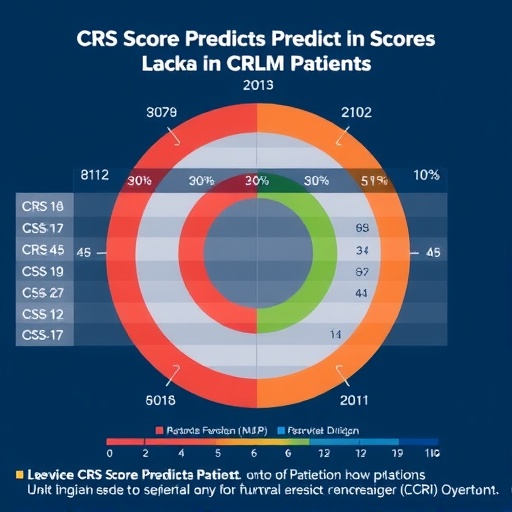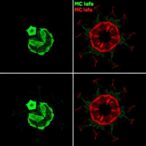
A groundbreaking study recently published in BMC Cancer has unveiled a robust prognostic model aimed at improving the clinical outcomes for patients suffering from synchronous colorectal liver metastasis (CRLM). This retrospective analysis from a single center meticulously crafted a predictive nomogram based on the CRS (Clinical Risk Score), shining new light on risk stratification and personalized treatment strategies. In a field where survival rates have historically been dismal, these findings could herald a transformative shift in managing this complex disease.
Colorectal liver metastasis represents a formidable challenge in oncology, largely because the liver often becomes the first and most common site of metastasis in colorectal cancer patients. For those diagnosed with synchronous metastatic disease—where liver metastases are identified simultaneously with the primary tumor—the therapeutic approach is complex and survival outcomes vary widely. Thus, the urgent need for precise prognostic tools cannot be overstated, fueling the inspiration behind this research.
The cohort comprised 389 CRLM patients who underwent systematic chemotherapy and synchronous hepatic resection, with some also receiving radiofrequency ablation (RFA). The patients were judiciously split into a larger training group of 273 individuals and a validation cohort of 116. This methodical division ensured the model’s predictive capability was tested and confirmed to be generalizable beyond the initial data set, a critical step in clinical model validation rarely emphasized to this extent in prior work.
Central to this study was the application of sophisticated statistical tools. The researchers employed receiver operating characteristic (ROC) curves, decision curve analysis (DCA), concordance indices (C-index), and calibration curves to rigorously evaluate model performance. These complementary techniques ensure not only discriminative ability but also the clinical utility and the accuracy of predicted survival probabilities, underscoring the pragmatic implementation potential of the nomogram in everyday oncologic practice.
The results were both compelling and clinically significant. Median overall survival (OS) stood at an impressive 70.2 months, while median recurrence-free survival (RFS) was 11.7 months. Notably, the nomogram successfully stratified patients into distinct high-risk and low-risk groups based on a calculated cut-off, with Kaplan-Meier analyses revealing statistically significant survival differences between these strata. This stratification empowers clinicians with data-driven prognostic insights, guiding therapeutic decisions tailored to individual patient risk profiles.
In dissecting the variables underpinning prognosis, the multivariate Cox regression analysis identified several independent factors influencing outcomes. Hospital stay duration, achievement of R0 resection (complete tumor removal with negative margins), utilization of RFA, receipt of only neoadjuvant chemotherapy, and importantly, the CRS score itself emerged as critical prognostic indicators. These findings foreground the multifactorial nature of CRLM management, incorporating surgical precision, adjunctive therapies, and baseline patient evaluation into survival predictions.
Interestingly, the role of R0 resection resurfaces as a cornerstone for survival benefits, a testament to surgical advances and oncologic vigilance. Patients achieving R0 margins demonstrated markedly better outcomes, reinforcing the surgical objective of complete tumor eradication whenever feasible. Equally, the inclusion of radiofrequency ablation as a complementary modality underscores an evolving therapeutic arsenal aimed at extending survival and enhancing quality of life in metastatic disease contexts.
The predictive model’s robustness was further validated by C-index values of 0.72 for OS and 0.68 for RFS in the training set, with similar reproducibility observed in the validation set (0.71 and 0.65, respectively). These concordance indices signal strong model discrimination, affirming that the nomogram reliably differentiates between patients with varying prognoses. Such reliability is essential for clinical trust and eventual integration into decision-making frameworks.
Calibration curves drawn in the study vividly demonstrated high agreement between predicted and observed survival outcomes, ensuring that the model does not merely discriminate but also accurately estimates absolute risk probabilities. This attribute is crucial for patient counseling, shared decision-making, and tailoring surveillance protocols, potentially mitigating over- or under-treatment risks.
Moreover, decision curve analysis illuminated the tangible clinical benefits of applying the model across different threshold probabilities. By juxtaposing net benefits against standard treatment paradigms, the DCA highlighted situations where the model could meaningfully inform therapeutic choices, thereby embodying a bridge between statistical prediction and real-world clinical impact.
The study’s retrospective nature and single-center design are acknowledged limitations; however, the rigor in methodology and internal validation instill confidence. Future multicenter prospective studies leveraging this nomogram could further refine predictive accuracy and solidify its position in personalized oncology care for CRLM patients.
From a biological perspective, the CRS score integrates diverse factors encompassing tumor burden, patient health status, and biological behavior, making it a valuable composite metric. Its integration into this prognostic framework exemplifies the convergence of clinical data analytics with the nuanced understanding of metastatic colorectal cancer’s heterogeneity.
Ultimately, this study illuminates a new horizon in managing synchronous colorectal liver metastasis, where informed stratification and personalized risk assessment could translate into optimized treatment pathways and, crucially, enhanced survival outcomes. As practitioners and researchers embrace precision oncology, tools such as this nomogram pave the way toward more nuanced, data-driven interventions.
In a broader oncological landscape, the increasing sophistication of predictive models equipped with rigorous validation aligns with the transformative goals of reducing mortality and refining resource allocation. This aligns with contemporary imperatives in cancer care, where tailoring treatments to individual risk profiles mitigates toxicity and maximizes therapeutic benefit.
As clinicians digest these findings, the integration of such models into multidisciplinary tumor boards and clinical workflows will be the next critical step. Implementation science efforts will be vital to overcome potential translation barriers, ensuring that statistical advancements translate into tangible patient benefits on a global scale.
By harnessing comprehensive clinical data and modern analytic techniques, this study exemplifies the palpable progression toward data-centric oncology. The fusion of retrospective clinical insight and predictive analytics heralds a future where every therapeutic decision is anchored in precision and personalized promise.
With survival extensions now observable in this challenging patient subgroup, the hope burgeons for more refined prognostic tools to continually evolve, shaping the future of metastatic colorectal cancer treatment. The convergence of surgery, chemotherapy, ablation techniques, and predictive modeling coalesces into a powerful arsenal poised to reshape clinical trajectories.
In conclusion, the novel prognostic nomogram emerging from this study in BMC Cancer represents a significant leap for synchronous CRLM management. By combining key clinical variables into a validated predictive tool, it offers both clarity and guidance in a historically opaque clinical domain. The future of CRLM care may well be defined by such data-driven, individualized approaches.
Subject of Research: Prognostic modeling and risk stratification in synchronous colorectal liver metastasis (CRLM) patients using CRS score
Article Title: Prognostic analysis of patients with CRLM based on CRS score: a single-center retrospective study
Article References:
Xue, Js., Maimaitiming, N., Zhang, Bl. et al. Prognostic analysis of patients with CRLM based on CRS score: a single-center retrospective study. BMC Cancer 25, 718 (2025). https://doi.org/10.1186/s12885-025-14135-7
Image Credits: Scienmag.com
DOI: https://doi.org/10.1186/s12885-025-14135-7
Tags: chemotherapy and hepatic resection in CRLMclinical outcomes in metastatic colorectal cancercolorectal cancer metastasis to liverCRS score in colorectal liver metastasispersonalized treatment strategies for CRLMpredictive nomogram for cancer prognosisprognostic model for CRLM patientsradiofrequency ablation for CRLM patientsretrospective analysis in cancer researchrisk stratification in oncologysurvival rates in synchronous metastatic diseasesynchronous colorectal liver metastasis challenges

